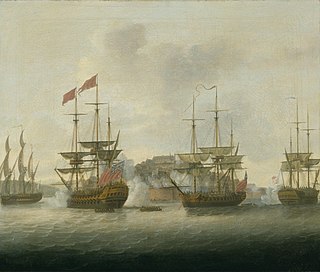
Piet Pieterszoon Hein was a Dutch admiral and privateer for the Dutch Republic during the Eighty Years' War. Hein was the first and the last to capture a large part of a Spanish treasure fleet which transported huge amounts of gold and silver from Spanish America to Spain. The amount of silver taken was so large that it resulted in the rise of the price of silver worldwide and the near bankruptcy of Spain.

France Antarctique was a French colony in Rio de Janeiro, in modern-day Brazil, which existed between 1555 and 1567, and had control over the coast from Rio de Janeiro to Cabo Frio. The colony quickly became a haven for Huguenots, and was ultimately destroyed by the Portuguese in 1567.

The Kingdom of Kongo was a kingdom in Central Africa. It was located in present-day northern Angola, the western portion of the Democratic Republic of the Congo, southern Gabon and the Republic of the Congo. At its greatest extent it reached from the Atlantic Ocean in the west to the Kwango River in the east, and from the Congo River in the north to the Kwanza River in the south. The kingdom consisted of several core provinces ruled by the Manikongo, the Portuguese version of the Kongo title Mwene Kongo, meaning "lord or ruler of the Kongo kingdom", but its sphere of influence extended to neighbouring kingdoms, such as Ngoyo, Kakongo, Loango, Ndongo, and Matamba, the latter two located in what is Angola today.

Dutch Brazil, also known as New Holland, was a colony of the Dutch Republic in the northeastern portion of modern-day Brazil, controlled from 1630 to 1654 during Dutch colonization of the Americas. The main cities of the colony were the capital Mauritsstad, Frederikstadt, Nieuw Amsterdam (Natal), Saint Louis, São Cristóvão, Fort Schoonenborch (Fortaleza), Sirinhaém, and Olinda.

The Dutch–Portuguese War was a global armed conflict involving Dutch forces, in the form of the Dutch East India Company, the Dutch West India Company, and their allies, against the Iberian Union, and after 1640, the Portuguese Empire. Beginning in 1598, the conflict primarily involved the Dutch companies and fleet invading Portuguese colonies in the Americas, Africa, and the East Indies. The war can be thought of as an extension of the Eighty Years' War being fought in Europe at the time between Spain and the Netherlands, as Portugal was in a dynastic union with Spain after the War of the Portuguese Succession, for most of the conflict. However, the conflict had little to do with the war in Europe and served mainly as a way for the Dutch to gain an overseas empire and control trade at the cost of the Portuguese.
The Battle of Kitombo was a military engagement between forces of the BaKongo state of Soyo, formerly a province of the Kingdom of Kongo, and the Portuguese colony of Angola on 18 October 1670. Earlier in the year a Portuguese expeditionary force had invaded Soyo with the intention of ending its independent existence. The Soyo were supported by the Kingdom of Ngoyo, which provided men and equipment, and by the Dutch, who provide guns, light cannon and ammunition. The combined Soyo-Ngoyo force was led by Estêvão Da Silva, and the Portuguese by João Soares de Almeida. Both commanders were killed in the battle, which resulted in a decisive victory for Soyo. Few, if any, of the invaders escaped death or capture.
The precolonial history of Angola lasted until Portugal annexed the territory as a colony in 1655.

Loango-Angola is the name for the possessions of the Dutch West India Company in contemporary Angola and the Republic of the Congo. Notably, the name refers to the colony that was captured from the Portuguese between 1641 and 1648. Due to the distance between Luanda and Elmina, the capital of the Dutch Gold Coast, a separate administration for the southern districts of Africa was established at Luanda during the period of the Dutch occupation.

The First Cevallos expedition was a series of Spanish military operations in South America during the Fantastic War. Under the command of the governor of Buenos Aires, Pedro Antonio de Cevallos, the expedition captured the Portuguese settlement of Colónia do Sacramento and fought off a joint Anglo-Portuguese attempt to recapture it. All military activities in the region concluded with the 1763 Treaty of Paris.

Angola–Brazil relations are the bilateral relations between Angola and Brazil. As former Portuguese colonies, Angola and Brazil share many cultural ties, including language and religion. Both nations are members of the Community of Portuguese Language Countries, Group of 77 and the United Nations.

Salvador Correia de Sá e Benevides was a Portuguese admiral and crown administrator. In 1625 he fought the Dutch invasion of Salvador in Brazil and regained Angola and São Tomé Island from the Dutch in 1647. He was the governor of Rio de Janeiro, parts of Southern Brazil and Angola.

The recapture of Bahia was a Spanish–Portuguese military expedition in 1625 to retake the city of Bahia in Brazil from the forces of the Dutch West India Company (WIC).

The capture of Salvador was a military engagement between Portugal and the Dutch West India Company, that occurred in 1624, and ended in the capture of the Brazilian city of Salvador by the latter. This capture was part of the Groot Desseyn plan of the Dutch West India Company. Although the Dutch intentions were reported to the Spanish no preventive counter-action was taken by them.

The Brazilian War of Independence was an armed conflict that led to the separation of Brazil from the United Kingdom of Portugal, Brazil and the Algarves. The war was fought across various regions of Brazil, including Bahia, Maranhão, Pará, Piauí, and Cisplatina, with naval battles occurring along the Atlantic coast. Brazilian forces, consisting of regular troops, local militias, and a hastily assembled fleet, defeated the Portuguese garrisons to establish the Empire of Brazil under emperor Pedro I. The war formally ended with the Treaty of Rio de Janeiro in 1825, in which Portugal recognized Brazil's independence.
The Groot Desseyn was a plan devised in 1623 by the Dutch West India Company to seize the Portuguese/Spanish possessions of the Iberian Union in Africa and the Americas, in order that the Spanish would not collect enough money for their war against the Netherlands.

The invasion of the Cape Colony, also known as the Battle of Muizenberg, was a British military expedition launched in 1795 against the Dutch Cape Colony at the Cape of Good Hope. The Dutch colony at the Cape, established and controlled by the United East India Company in the seventeenth century, was at the time the only viable South African port for ships making the journey from Europe to the European colonies in the East Indies. It therefore held vital strategic importance, although it was otherwise economically insignificant. In the winter of 1794, during the French Revolutionary Wars, French troops entered the Dutch Republic, which was reformed into the Batavian Republic.

The Recapture of Recife was a military engagement between the Portuguese forces under Francisco Barreto de Meneses and the Dutch forces of Captain Walter Van Loo. After the Dutch defeats at Guararapes, their surviving men, as well as other garrisons of New Holland, joined in the area of Mauritsstad in order to make a last stand. However, after fierce fighting, the Portuguese victoriously entered the city and the remaining Dutch were ousted from Brazil.

The battle of Pungo Andongo, was a military engagement in what is today Angola between Portugal and the Kingdom of Ndongo whose capital, Pungo Andongo, also known as Pedras Negras, was besieged. After a 9-month long encirclement, the capital was taken by storm, plundered, and occupied by the Portuguese.

The Insurrection of Pernambuco, also known as the War of the Divine Light, was a movement against Dutch rule in the Captaincy of Pernambuco. The revolution occurred in the course of the second Dutch invasion during the Dutch–Portuguese War and resulted in the expulsion of the Dutch from the northeast region of Brazil, followed by the reclamation of the territory by the Kingdom of Portugal.

The Filips van Zuylen's campaign agaisnt Luanda took place in 1624, it was an episode of the Dutch-Portuguese War that resulted in a heavy defeat for the Dutch West India Company. After two failed attempts to conquer the city, the invading forces would retreat.
















